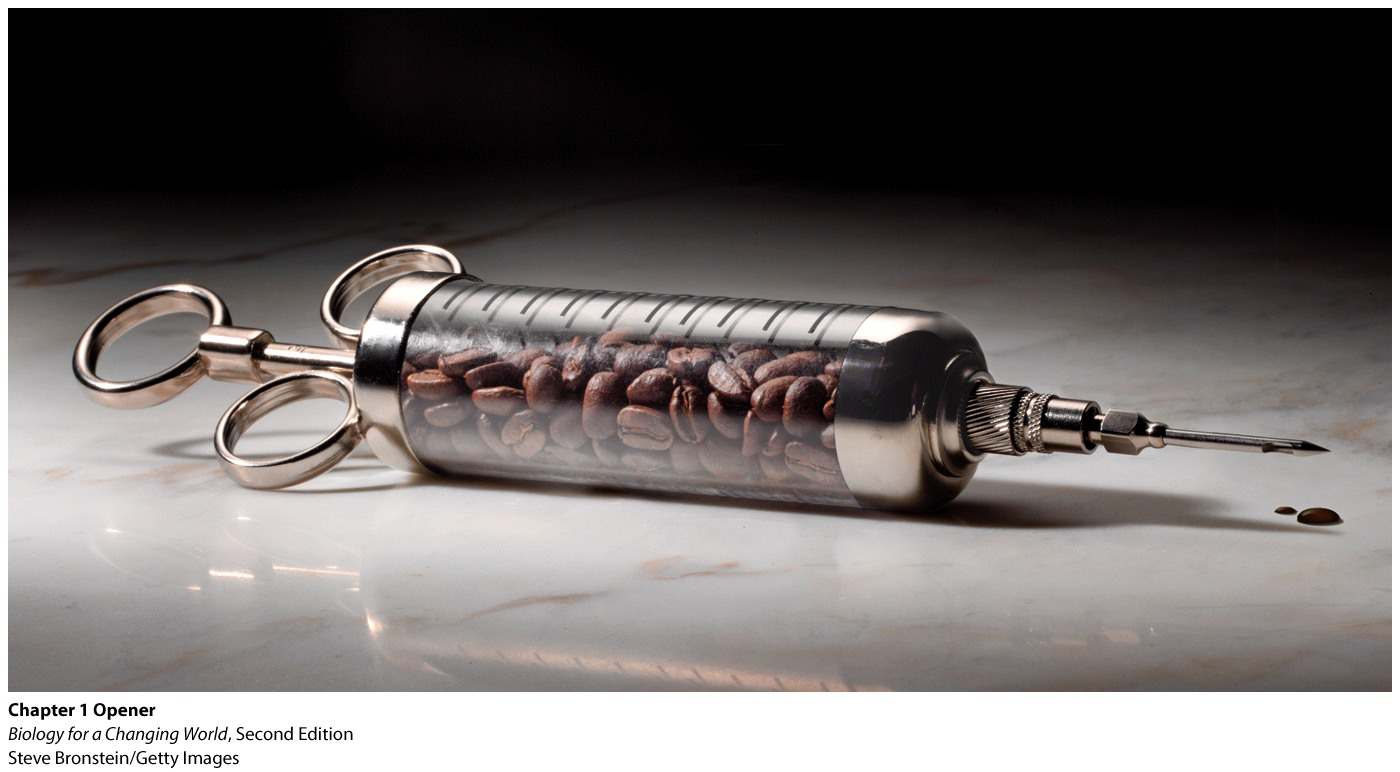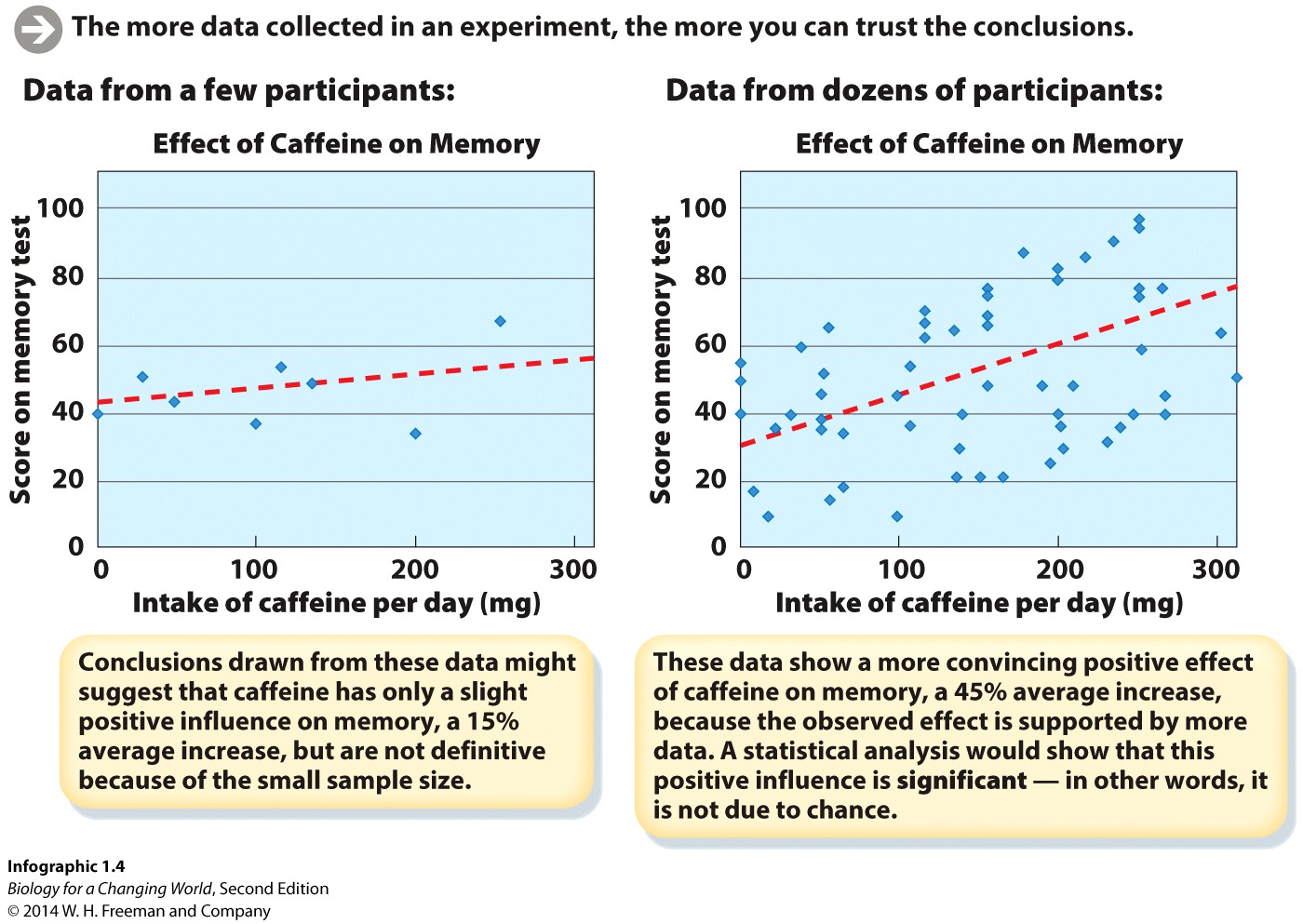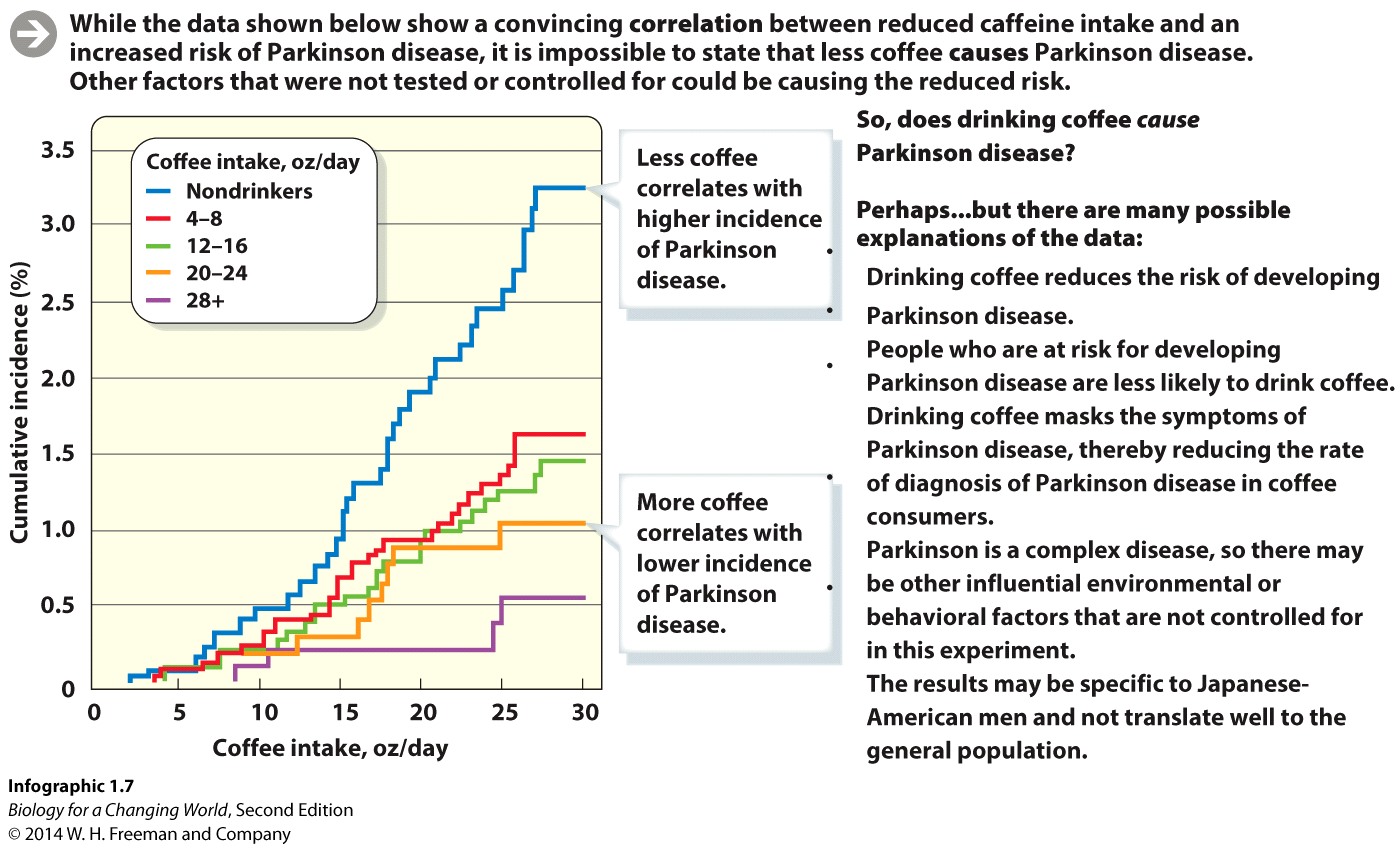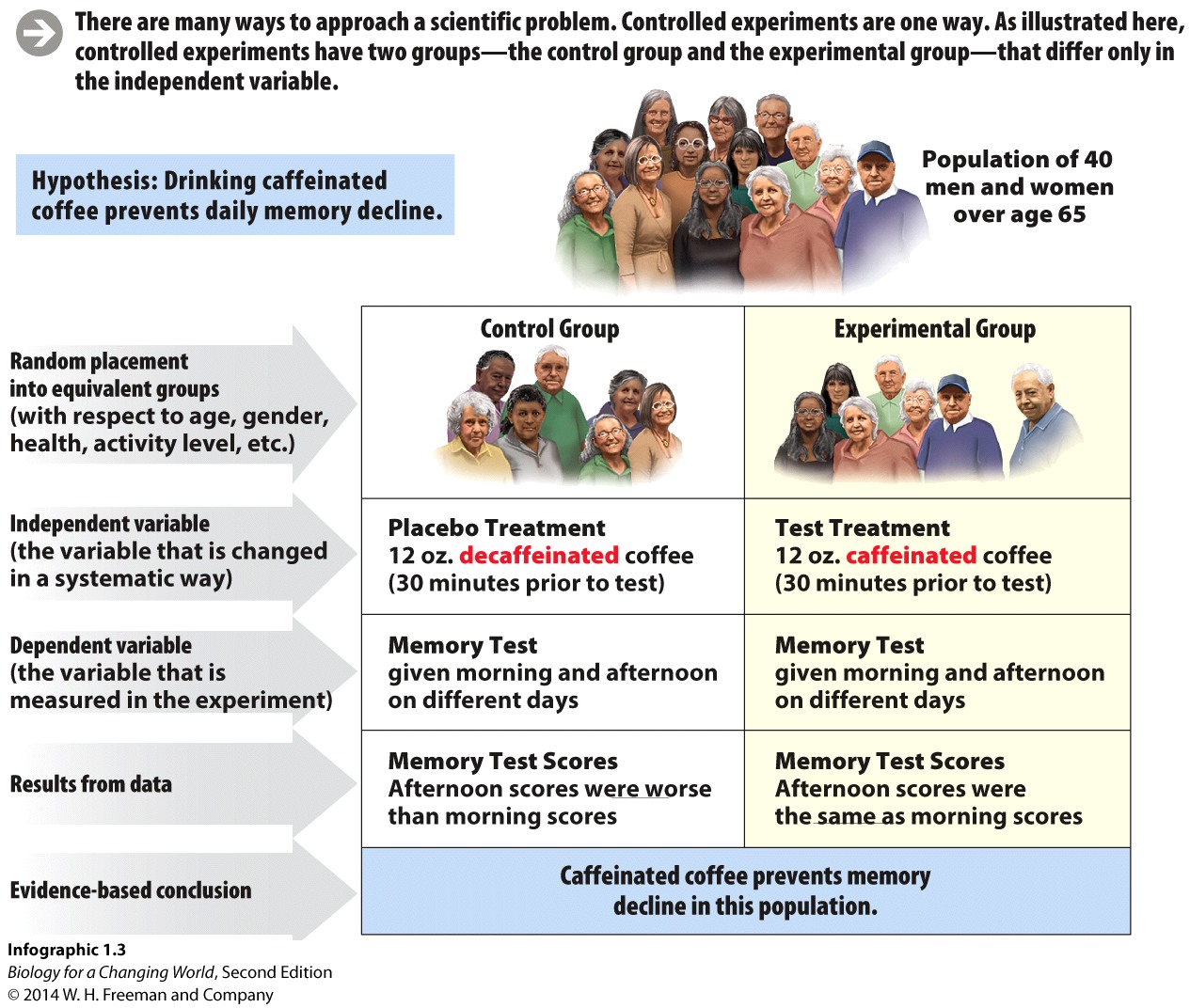
Chapter 1. Chapter 1: Process of Science
1.1 Introduction


Welcome to the Interactive Study Guide for Chapter 1: Process of Science! This Study Guide will help you master your understanding of the chapter's Driving Questions, using interactive Infographics and activities, as well as targeted assessment questions. Click "Next" to get started, or select a Driving Question from the drop-down menu to the right.
Java Report:
Making sense of the latest buzz in health-related news
DRIVING QUESTIONS
- How is the scientific method used to test hypotheses?
- What factors influence the strength of scientific studies and whether the results of any given study are applicable to a particular population?
- How can you evaluate the evidence in media reports of scientific studies?
- How does the scientific method apply in clinical trials designed to investigate important issues in human health?
1.2 Driving Question 1
Driving Question 1
How is the scientific method used to test hypotheses?
Why should you care?
When we understand how science works and how scientific evidence is obtained, interpreted and refined, we can analytically and critically evaluate the findings we read about in the media. Then we can make good, evidence-based decisions about our lifestyle choices rather than following the latest fads.
What should you know?
To fully answer this Driving Question, you should be able to:
- Describe and discuss the process of science from initial observations to publishable results.
- Compare and contrast the conclusions generated by rigorous scientific study and those generated anecdotally.
Test Your Vocabulary
Choose the correct term for each of the following definitions:
| Term | Definition |
|---|---|
| An informal observation that has not been systematically tested. | |
| A tentative explanation for a scientific observation or question. | |
| A carefully designed test, the results of which will either support or rule out a hypothesis. | |
| A process in which independent scientists read and critique scientific studies before they are published to ensure that the authors have appropriately designed and interpreted the study. | |
| The process of using observations and experiments to draw conclusions based on evidence. | |
| (A hypothesis) demonstrably ruled out by data showing that the hypothesis does not explain the observation. | |
| Subject to support or rejection (of a hypothesis) according to carefully designed experiments or observational studies. |
Describe and discuss the process of science from initial observations to publishable results.
1.
Describe the steps in the process of science.
2.
Which of the steps in the process should be repeated if the hypothesis in question is to be more rigorously tested? Explain.
Compare and contrast the conclusions generated by rigorous scientific study and those generated anecdotally.
3.
What is anecdotal evidence?
4.
How are conclusions generated by rigorous scientific study similar to or different from those generated anecdotally?
Review Questions
5.
What is typically the order of the scientific process?
| A. |
| B. |
| C. |
| D. |
6.
True or False: A question and a hypothesis are the same thing.
| A. |
| B. |
7.
In a scientific experiment, which group would typically receive a placebo treatment?
| A. |
| B. |
| C. |
8.
Once a scientific hypothesis has been tested and supported by one scientist in one study:
| A. |
| B. |
| C. |
| D. |
| E. |
1.3 Driving Question 2
Driving Question 2
What factors influence the strength of scientific studies and whether the results of any given study are applicable to a particular population?
Why should you care?
The strength of a scientific study’s conclusions depends on the quality of the study’s design. Controlled experiments are one of the most powerful tools scientists use to test hypotheses. Understanding the characteristics of a good controlled experiment helps us evaluate the conclusions we read about in media reports. Sample size is also a critical component of good research design. Typically, conclusions from studies with small sample sizes are only weakly supported. When you read media reports, one of the first things you should look for is sample size; if it is small or if it is not reported, you should remain skeptical about the reported conclusions.
What should you know?
To fully answer this Driving Question, you should be able to:
- Compare and contrast the control and experimental groups of a controlled experiment.
- Describe the design of a controlled experiment.
- Illustrate and discuss the significance of sample size on the strength of conclusions drawn from scientific studies.
Infographic Focus
The infographics most pertinent to the Driving Question are 1.3, 1.4, and 1.7.
Test Your Vocabulary
Choose the correct term for each of the following definitions:
| Term | Definition |
|---|---|
| A fake treatment given to control groups to mimic the experience of the experimental groups. | |
| The measured result of an experiment analyzed in both the experimental and control groups. | |
| The group in an experiment that undergoes the experimental intervention or manipulation. | |
| The group in an experiment that undergoes no experimental intervention or manipulation. | |
| The variable, or factor, being deliberately changed in the experimental group. | |
| A measure of confidence that the results obtained are “real” and not due to chance. | |
| The number of experimental subjects or the number of times an experiment is repeated. In human studies, sample size is the number of participants. |
Compare and contrast the control and experimental groups of a controlled experiment.
9.
Lee Ryan began her coffee-drinking study with a sample population of 40 men and women over age 65, divided into two groups.
List the similarities and differences between the control and experimental groups.
- Adults all over 65 years old
- Groups equally composed based on gender, health, and activity level
- Both given 12 ounces of beverage to drink 30 minutes prior to memory test
- Both given memory tests in the mornings and afternoons of different days
Differences:
- Control group given placebo (decaffeinated coffee)
- Experimental group given treatment (caffeinated coffee)
- Afternoon memory test scores the same as morning test scores in the Experimental group
- Afternoon memory test scores worse than morning test scores in the Control group
10.
Why are the similarities between the two groups important?
11.
Why are differences between the groups important?
Describe the design of a controlled experiment.
12.
Describe the experimental design of Dr. Ryan’s coffee drinking study by answering the following questions.
What was the independent variable?
13.
How did Dr. Ryan make the independent variable different between the experimental and control groups (i.e., what “treatment” did the experimental group receive and what “treatment” did the control group receive)?
14.
How did Dr. Ryan control for a placebo effect?
15.
What was the dependent variable?
16.
How was the dependent variable measured? Was it measured differently in the control and experimental groups?
17.
Describe the significance of using good experimental design by answering the following questions.
Could Dr. Ryan’s conclusions have been drawn if the experimental and control group differed in a trait such as age, sex, ethnicity, or health status? Explain.
18.
Could Dr. Ryan’s conclusions have been drawn if she had not controlled for a placebo effect? Explain.
19.
Could Dr. Ryan’s conclusions have been drawn if she had measured the dependent variable differently in the control and experimental groups? Explain.
Illustrate and discuss the significance of sample size on the strength of conclusions drawn from scientific studies.
20.

Examine the two graphs from Infographic 1.4. For each, write a one-sentence statement of what the graph shows about the relationship between milligrams of caffeine per day and score on the memory test.
21.
The following table contains hypothetical data from a study of the effects of caffeine consumption on a test of short-term memory in college students.
| Participant | Caffeine (mg) | Test Score (points out of 100) |
|---|---|---|
| 1 | 0 | 20 |
| 2 | 50 | 30 |
| 3 | 100 | 60 |
| 4 | 150 | 100 |
| 5 | 200 | 100 |
| 6 | 0 | 55 |
| 7 | 50 | 70 |
| 8 | 100 | 45 |
| 9 | 150 | 50 |
| 10 | 200 | 40 |
| 11 | 0 | 60 |
| 12 | 50 | 40 |
| 13 | 100 | 35 |
| 14 | 150 | 40 |
| 15 | 200 | 45 |
Graph the results for the first five participants and write a one-sentence statement explaining what it shows about the relationship between caffeine consumption and short-term memory.

Increased consumption of caffeine greatly enhanced performance on a short-term memory test.
22.
On the same graph, show the results for the remaining participants and write a one-sentence statement explaining what it shows about the relationship between caffeine consumption and short-term memory.

Increased consumption of caffeine slightly enhanced performance on a short-term memory test.
23.
Explain why your conclusions differ in terms of individual participants.
24.
Explain why the conclusions based on the larger sample (15) are more reliable than those based on the smaller sample (5).
25.
Now look at the statements you wrote about the graphs in Infographic 1.4. Which of the two sets of data is more reliable? Why?
Review Questions
26.
Use this scenario to answer questions 26 to 28:
You wish to test the effects of energy drinks on short-term memory in college students. You recruit 100 volunteers for your study. The control group will receive a placebo and the experimental group the same volume of Red Bull. You will administer a test of short-term memory 30 minutes after participants consume their drinks.
Which of the following best describes how you would assign participants to your experimental and control groups?
| A. |
| B. |
| C. |
| D. |
| E. |
27.
In your study, the independent variable and dependent variable are (in that order):
| A. |
| B. |
| C. |
| D. |
28.
Should the control group know that it is receiving the placebo?
| A. |
| B. |
| C. |
| D. |
| E. |
29.
Your aunt told you that she is going to change her brand of breakfast cereal to one that is higher in vitamin E. She has based her decision on a news report of a scientific study finding that adults who ate vitamin E-fortified cereal had better cardiovascular health than did those who ate other kinds of cereal. You are skeptical, so you track down the original scientific article and discover that the sample size for the study was five individuals. What do you tell your aunt?
| A. |
| B. |
| C. |
| D. |
| E. |
1.4 Driving Question 3
Driving Question 3
How can you evaluate the evidence in media reports of scientific studies?
Why should you care?
Most of us are not health care professionals. Lacking the knowledge and skills to read, understand, and synthesize all of the scientific literature about human health, we must rely instead on media reports to stay informed of the latest findings and trends. We cannot, however, take those reports at face value. We need a proper understanding of the process of science to critically evaluate what we read and to use what we read to make good decisions about our own lifestyle choices. Understanding how and why important details may be missing from media reports is the final piece to helping you become a critical and analytical consumer of scientific news.
What should you know?
To fully answer this Driving Question, you should be able to:
- Compare and contrast the everyday and scientific meanings of the word “theory.”
- Explain why a correlation in a scientific study does not necessarily indicate a cause-and-effect relationship.
- Explain why media headlines may not accurately convey the results of scientific studies.
- List and describe the questions a skeptical consumer should ask about a media report before accepting the reported conclusions at face value.
Infographic Focus
The infographics most pertinent to the Driving Question are 1.2, 1.3, 1.4, 1.5, 1.7, and 1.8.
Test Your Vocabulary
Choose the correct term for each of the following definitions:
| Term | Definition |
|---|---|
| A controlled medical experiment in which subjects are randomly chosen to receive either an experimental treatment or a standard treatment (or placebo). | |
| An explanation of the natural world that is supported by a large body of evidence and has never been disproved. | |
| A consistent relationship between two variables. |
Compare and contrast the everyday and scientific meanings of the word “theory.”
30.
List the way(s) in which the two meanings of the word “theory” are similar.
31.
List the way(s) in which the two meanings of the word “theory” are different.
Explain why a correlation in a scientific study does not necessarily indicate a cause-and-effect relationship.
32.

Based on the epidemiological study mentioned in the textbook, does caffeine cause a reduction in the risk of developing Parkinson disease? If not, how do you explain the pattern shown on the graph in Infographic 1.7?
33.
What principle about correlation and cause-and-effect relationships does this example illustrate?
Explain why media headlines may not accurately convey the results of scientific studies.
34.
List the limitations of media reports that may prevent reporters from including all relevant details of a scientific study.
List and describe the questions a skeptical consumer should ask about a media report before accepting its conclusions.
35.
List and describe the questions a skeptical consumer should ask about a media report before accepting its conclusions.
Did it have proper controls?
What was the experimental group? What was the control group?
Were all variables taken into consideration?
How were the experiments performed?
How were the data analyzed?
What do the data suggest?
Look for yourself; do not depend on someone else’s interpretation of the data, unless that person is a trusted scientific source.
When in doubt, talk about the study to someone who is familiar with the discipline or area of research.
Go straight to the source!
READ THE ORIGINAL RESEARCH PAPER the article is based on.
Review Questions
36.
“I feel more cheerful when I wear bright clothing therefore bright clothing makes people more cheerful” is an example of a(n): (mark "true" for all correct answers)
a. scientific theory
b. everyday theory
c. hypothesis
d. data
37.
In one study, a researcher found that people who were below 5 feet 5 inches in height were relatively unlikely to have red hair. This is an example of:
| A. |
| B. |
38.
When reading media stories about scientific discoveries, I will:
| A. |
| B. |
| C. |
| D. |
1.5 Driving Question 4
Driving Question 4
How does the scientific method apply in clinical trials designed to investigate important issues in human health?
Why should you care?
When you understand the elements of good scientific studies and some of the cautions that you must exercise when interpreting their results, you are better prepared to take information transmitted through popular media and decide, as an educated consumer, how it affects you.
What should you know?
To fully answer this Driving Question, you should be able to:
- Use all of the information learned in this chapter to assess the claims and evidence reported in clinical trials.
Infographic Focus
All of the infographics are pertinent to the Driving Question.
Test Your Vocabulary
Choose the correct term for each of the following definitions:
| Term | Definition |
|---|---|
| Subject to support or rejection (of a hypothesis) according to carefully designed experiments or observational studies. | |
| An informal observation that has not been systematically tested. | |
| A tentative explanation for a scientific observation or question. | |
| The measured result of an experiment analyzed in both the experimental and control groups. | |
| The group in an experiment that undergoes the experimental intervention or manipulation. | |
| A fake treatment given to control groups to mimic the experience of the experimental groups. | |
| A measure of confidence that the results obtained are “real” and not due to chance. | |
| A consistent relationship between two variables. | |
| The study of patterns of disease in populations, including risk factors. | |
| The number of experimental subjects or the number of times an experiment is repeated In human studies, sample size is the number of participants. | |
| A process in which independent scientists read scientific studies before they are published to ensure that the authors have appropriately designed and interpreted the study. | |
| carefully designed test, the results of which will either support or rule out a hypothesis. | |
| A controlled medical experiment in which subjects are randomly chosen to receive either an experimental treatment or a standard treatment (or placebo). | |
| explanation of the natural world that is supported by a large body of evidence and has never been disproved. | |
| The group in an experiment that undergoes no experimental intervention or manipulation. | |
| (A hypothesis) demonstrably ruled out by data showing that the hypothesis does not explain the observation. | |
| The variable, or factor, being deliberately changed in the experimental group. | |
| The process of using observations and experiments to draw conclusions based on evidence. |
39.
Read the summary provided as a popular media report of the peer-reviewed article “Insufficient Sleep Undermines Dietary Efforts to Reduce Adiposity” by Nedeltcheva et al. (Annals of Internal Medicine 153:435-441, 5 October 2010) and answer the questions. Note that some questions address the scientific study itself while others address the way in which the study is reported. Both are important!
Excerpt from the Media Report
Sleeping Helps You Lose!
Researchers from the University of Chicago and the University of Wisconsin, Madison, recently reported new findings on the relationship between sleep and weight loss. In a randomized clinical trial, subjects getting 5.5 hours of sleep over a 2-week period lost the same amount of weight as their counterparts getting 8.5 hours of sleep. But subjects on the low-sleep regimen lost significantly more lean muscle and significantly less body fat than did subjects on the long-sleep regimen. Therefore, the more sleep you get, the more body fat you will lose!
Excerpt from the Research Paper
The study examined sleep and weight loss in 10 overweight, non-smoking individuals (3 women and 7 men). Subjects were randomly assigned to two treatments: 8.5 hours of sleep or 5.5 hours of sleep. All subjects were given the same moderately restricted diet, moderate exercise regimen and studied for 2 weeks in a sleep laboratory. Investigators measured fat loss and fat-free body mass as well as several physiological variables related to how the body uses energy. Based on the results, insufficient sleep undermines dietary efforts to reduce body fat.

What type of study is this? Diagram the study, being sure to identify (a) the question being asked, (b) control group and experimental group, (c) the independent variable, (d) the dependent variable and how it was measured, and (e) the conclusions the authors of both articles reached. (Hint: Use the scheme illustrated in Infographic 1.3.)
(b)Control Group:
Moderately restricted diet
Moderate exercise regimen
2 weeks in Sleep Lab
Weight Measurement: percent body fat vs. body mass
Weight Result: lost more lean muscle and less fat
Experimental Group:
Moderately restricted diet
Moderate exercise regimen
2 weeks in Sleep Lab
Weight Measurement: percent body fat vs. body mass
Weight Result: lost more fat and less lean muscle
(c)Independent variable: length of sleep
(d)Dependent variable: weight loss through body fat and lean muscle reduction
Measurement: weight, percent body fat, and total body mass
(e)Conclusion of media report author: More sleep will make you lose more body fat.
Conclusion of research paper author: Sleeping 5.5 hours per night will cause you to lose less body fat and more lean muscle when reducing calorie intake than people getting 8.5 hours of sleep.
40.
What is the sample size of the study? Does the size of the sample influence your confidence in the results of the study? Explain. Do any of the other features of the study design reduce your confidence in the results? Explain.
I would not have much confidence in this study based on these design shortfalls.
41.
Does the study report a correlation, a causal relationship, or both? If it’s a correlation and not a causal relationship, offer at least one explanation for the correlation other than the effects of sleep itself.
42.
Does the media report include sufficient detail about the study for you to make an informed decision about the strength of the author’s conclusion? If not, which details are missing and why are they important?
Activity results are being submitted...